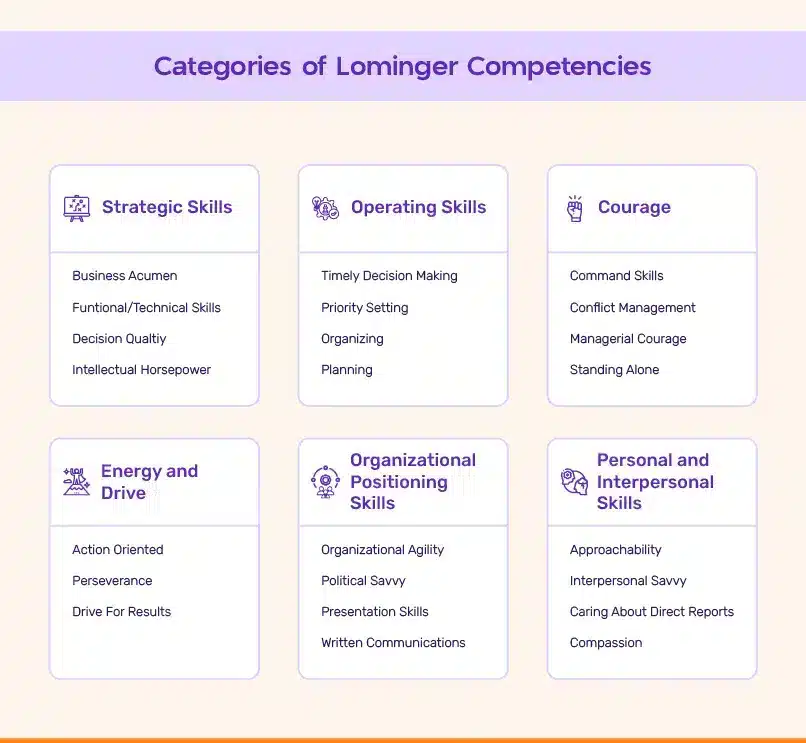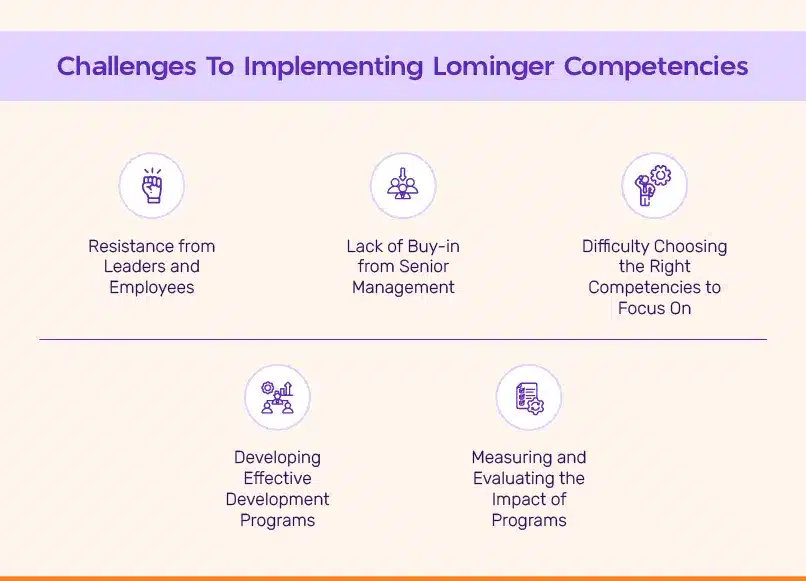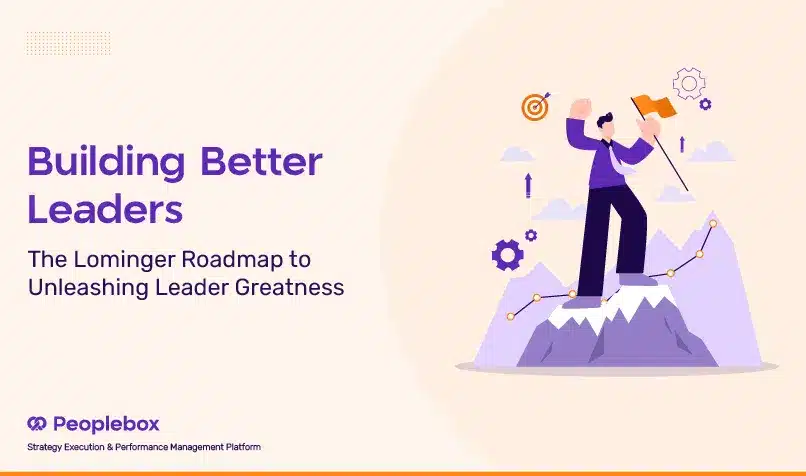In multi-dimensional working environments where deadlines are tight, and stakes are high, it becomes imperative for managers and leaders to navigate complex challenges of team management and lead with confidence. As teams become more diverse and projects become highly demanding, managers are expected to guide through uncertainties, resolve disputes with empathy, and foster a culture of resilience and innovation.
In such a dynamic leadership landscape, the Lominger Competencies stand out as a framework for achieving success and growing companies. In this post, we’ll explore how the Lominger Competencies framework can help managers navigate these complexities with confidence.
What are Lominger 67 Competencies?
The Lominger Competencies model, developed in 1991 by Michael Lombardo and Robert Eichinger, offers a robust framework for talent development and leadership grooming. With 67 key skills, it serves as a vital resource for HR professionals and leaders to enhance individual performance and meet organizational goals effectively.
Studies reveal that organizations embracing defined leadership competencies see remarkable benefits. With 1.8 times higher leadership quality, 1.4 times greater success rates in leadership roles, and a 1.5 times stronger talent pool, the advantages are clear.
The essence of this method lies in offering a clear method to recognize and refine the traits that distinguish exceptional leaders. By adopting this approach, you’re not just honing skills; you’re fostering a culture of continuous improvement and excellence.
Imagine a tech startup aiming to boost leadership effectiveness. By adopting the Lominger Competencies model, they empower their managers with targeted skills like “decision quality” and “collaboration.” The result? Faster project deliveries, improved team cohesion, and higher job satisfaction. The model becomes a catalyst for success, attracting top talent seeking growth in a culture that values continuous improvement and excellence.
What are the 67 Lominger Competencies?
The 67 Lominger Competencies encompass a wide array of skills and attributes essential for personal and professional success. Here’s a breakdown of these competencies across different categories:

Strategic Skills: These competencies focus on the ability to think strategically and navigate complex challenges in the business landscape. Here’s a glance at what competencies fall under this:
- Business acumen
- Functional/technical skills
- Technical learning
- Decision quality
- Intellectual horsepower
- Learning on the fly
- Problem solving
- Dealing with ambiguity
- Creativity
- Innovation management
- Perspective
- Strategic agility
Operating Skills: Operating skills are crucial for effectively managing day-to-day tasks and operations. This includes:
- Timely Decision Making
- Priority Setting
- Organizing
- Planning
- Time Management
- Delegation
- Developing Direct Reports and Others
- Directing Others
- Informing
- Managing and Measuring Work
- Process Management
- Managing Through Systems
- Total Work Systems
Courage: Courageous individuals demonstrate the strength to make tough decisions, confront challenges head-on, and stand up for what they believe in. Skills in this category include:
- Command skills
- Conflict management
- Managerial courage
- Standing alone
- Hiring and staffing
- Sizing up people
Energy and Drive: Individuals with high energy and drive possess a strong motivation to achieve results and persevere in the face of obstacles. Skills in this category include:
- Action oriented
- Perseverance
- Drive for results
Organizational Positioning Skills: These competencies are essential for navigating within an organization and building influence. They include skills such as:
- Organizational agility
- Political savvy
- Presentation skills
- Written communications
- Career ambition
- Comfort around higher management
Personal and Interpersonal Skills: Personal and interpersonal skills are vital for building effective relationships and fostering collaboration. They include skills such:
- Approachability
- Interpersonal Savvy
- Caring About Direct Reports
- Compassion
- Boss Relationships
- Customer Focus
- Managing Diversity
- Fairness to Direct Reports
- Peer Relationships
- Understanding Others (groups)
- Motivating Others
- Negotiating
- Building Effective Teams
- Managing Vision and Purpose
- Ethics and Values
- Integrity and Trust
- Composure
- Humor
- Listening
- Patience
- Personal Disclosure
- Dealing with Paradox
- Personal Learning
- Self-Development
- Self-Knowledge
- Work/Life Balance
Each of the skills is defined by specific behaviors, which makes it easy for you to assess, give feedback, and plan for development. This structured method not only helps you focus on improving specific skills but also ensures that your personal growth supports the strategic aims of the enterprise, powering a culture of continuous learning and improvement.
Now that we know what the Lominger competencies are, let us look at why you should integrate them.
Why Integrate Lominger Competencies?
Integrating the Lominger Competencies model is crucial for any company aiming to refine leadership skills and adapt swiftly to the ever-changing business environment. This strategic move ensures that you, as a leader, are well-equipped to tackle challenges head-on, fostering a culture of continuous improvement.
Benefits of Leadership Development
Let’s have a look at some of the standout benefits of integrating Lominger Competencies for leadership development:
- Targeted Skill Development: The model provides a clear roadmap for identifying and honing the specific skills you need to excel.
For instance, you can use the competencies to improve your strategic thinking ability, enabling the team to plan for customer satisfaction more effectively in the future. This targeted approach ensures efforts are focused on developing capabilities that make a real difference. - Boosted Performance: Leaders who master these competencies are better prepared to lead their teams to success, significantly driving up overall performance. Consider the case of a sales team leader who enhances motivational skills, leading to improved sales target achievement. It is all about transforming your potential into tangible results you can see and measure.
- Smarter Decision-Making: With competencies like strategic agility and problem-solving, making informed decisions becomes your second nature. An example could be a project manager utilizing improved problem-solving skills to navigate a project’s challenges pertaining to some external customers, ensuring it stays on track. This can help you contribute to successful outcomes across the business.
- Enhanced Team Engagement: Emotional intelligence and communication competencies enable you to create a positive and productive work environment. Imagine a department head who uses emotional intelligence to resolve conflicts within their team, leading to a better rapport and more cohesive team dynamics. After all, happy teams are productive teams, and they do not shy away from putting in the extra effort.
- Long-Term Success: The model emphasizes continuous learning, ensuring that your leadership skills evolve with the business. As a leader who consistently works on clarity and adaptability, you are in a better position to lead the company through change, keeping the team agile and prepared for future challenges. This sets the stage for sustained success, ensuring that the business remains competitive and innovative over time.
Suggested Read: 40+ Leadership Competencies with Examples
Aligning with Organizational Goals
By aligning the Lominger Competencies with the company’s goals, you can ensure your effectiveness in a leadership role. This strategic alignment ensures that your team is a formidable force propelling the business toward its aspirations.
- Clear Expectations: This alignment is crucial as it lays down the path to success for you as a leader. By understanding exactly what is expected, you can channel your efforts effectively, focusing on initiatives that directly contribute to the company’s growth. This approach eliminates guesswork and aligns your development with the bigger picture.
- Strategic Focus: Integrating Lominger Competencies with key objectives, like improved customer focus or better customer service, ensures that every decision and action by your team reinforces the company’s vision. This focused approach amplifies the impact of your strategies, making the goals more attainable.
- Effective Talent Management: Knowing which competencies align with the company goals allows for better strategic talent management. You are in a better position to identify and nurture the best talent for the right roles, ensuring that your team is well-equipped to meet the objectives.
- Greater Adaptability: The modern business landscape is dynamic, and adaptability is crucial for survival and success here. When equipped with the required competencies, you can quickly adapt to changes, turning potential challenges into growth opportunities.
- Accelerated Growth: When the development of your team is in sync with the company’s ambitions, it creates a powerful synergy that drives the enterprise toward innovation, efficiency, and growth.
How to Integrate Lominger Competencies?
Integrating Lominger Competencies into your development plan is a strategic process. Here’s how to do it effectively:
Selecting Relevant Competencies
The first step is to identify which of the Lominger 67 Competencies are most relevant to your company’s goals and the specific roles within the leadership team.
For example, if your company aims to enhance innovation, focus on competencies like ‘creativity’ and ‘innovation management’. Similarly, for a company looking to expand globally, competencies such as ‘global business knowledge’ and ‘cultural awareness’ would be crucial.
This approach ensures that your development efforts are directly contributing to the strategic objectives of the enterprise.
Assessing Current Leadership Capabilities
After you identify, the next step is to assess your current capabilities against these competencies. This assessment can be completed through a variety of tools such as 360-degree feedback, self-assessments, or even external assessments designed specifically for the Lominger Competencies.
For instance, a leader might discover through feedback that they need to work on ‘conflict management’. This assessment phase is crucial for setting a baseline and identifying specific areas for your development.
Suggested read: Self-Evaluation Examples: Empower Your Workforce for Success
Developing Targeted Interventions
With a clear understanding of the gaps and strengths in your capabilities, you can now design targeted interventions. This might include customized training sessions focused on specific competencies, one-on-one coaching for deeper personal development, or mentoring programs that pair leaders with mentors who excel in the desired areas.
For example, a leader lacking in ‘strategic agility’ might benefit from a specialized workshop on strategic planning and execution coupled with mentoring sessions with a senior leader known for their strategic insights.
Measuring Progress and Impact
The final step is to measure your progress in developing the targeted competencies and the impact on your leadership effectiveness and organizational performance. This can involve regular check-ins, follow-up assessments, and gathering feedback from your team and peers.
With Performance Management platforms like Peoplebox, setting up regular check-ins and one-on-ones is a breeze.

Additionally, linking competency development to key performance indicators (KPIs) can help quantify the impact. For example, an improvement in ‘team leadership’ competencies might be measured by increased team productivity or higher employee engagement scores. Similarly, improving ‘innovation management’ abilities might result in more new product ideas or happier customers. This approach helps organizations track progress effectively and make informed decisions for ongoing improvement and success.
Challenges of Implementing Lominger Competencies Model
While integrating the Lominger Competencies into your leadership development strategy offers numerous benefits, you may encounter several challenges along the way.

Resistance from HR Leaders and Employees
One common challenge is the resistance you might face from other leaders and employees. This resistance often results from a lack of understanding of the benefits or fear of the unknown.
For example, some team members might view the new competencies as additional requirements that complicate their work life rather than tools designed to enhance their performance and career prospects.
Lack of Buy-in from Senior Management
Co-operation from senior management is crucial for the successful implementation of the Lominger Competency model. Without support from the top, it can become challenging for you to allocate the necessary resources and drive the initiative forward.
This lack of buy-in can delay the implementation process, as senior management’s commitment is essential for legitimizing the effort and motivating others to participate.
Difficulty Choosing the Right Competencies to Focus On
With 67 competencies to choose from, identifying the most relevant ones for your organization can be challenging. The risk here is spreading your efforts too much or focusing on competencies that don’t align closely with your strategic objectives.
This selection process requires a deep understanding of the company’s current capabilities and future needs.
Developing Effective Development Programs
Creating development programs that effectively target the chosen competencies is another hurdle facing several leaders and HR teams. You need to ensure that these programs are tailored to meet the needs of diverse individuals and teams.
Moreover, they also need to be engaging and practical to make sure that learning is effectively transferred to the workplace.
Measuring and Evaluating the Impact of Programs
Measuring and evaluating the impact of these development programs presents its own set of challenges for you. Establishing clear metrics and collecting relevant data to assess their effectiveness in achieving the desired goals can be complex.
This step is crucial for demonstrating the returns on investment and securing ongoing support for the initiative.
Addressing the Challenges
Implementing the Lominger Competencies model can be complex, but with the right approach, you can overcome common hurdles and unlock the full potential of your leadership development initiatives. Here are practical steps to navigate these challenges effectively:
Involving Leaders and Employees in the Model Selection and Implementation
Ensure that other leaders and employees are part of the process from the start. By involving them in selecting which competencies are most relevant to their roles and the company goals, you create a sense of ownership to performance management and reduce resistance.
For instance, develop a specific task force that includes representatives from various levels within the enterprise to discuss and select the competencies. This collaborative approach not only enhances buy-in but also ensures the selected competencies are directly aligned with your strategic needs.
Communicating the Benefits of the Model to All Stakeholders
Clear and consistent communication about the benefits of the Lominger Competencies model is crucial. You may use meetings, workshops, and internal communications to highlight success stories and potential gains, such as improved leadership effectiveness and team performance.
For example, share case studies of how competitors have seen significant improvements in leadership quality and business outcomes after implementing the model.
Getting Buy-in from Senior Management by Demonstrating the ROI of Leadership Development
To secure senior management’s buy-in, present a clear business case demonstrating the ROI of investing in leadership development. Use data and industry benchmarks to show how the competencies contribute directly to improved performance, innovation, and competitive advantage.
For example, detail how enhanced leadership skills can lead to higher employee engagement, which is linked to increased profitability.
Using a Data-driven Approach to Select and Prioritize Competencies
Adopt a data-driven approach to identify and prioritize the competencies most critical to your company’s success. Conduct assessments or employee surveys to understand current leadership strengths and gaps and use this data to focus on areas with the highest impact. This method ensures your efforts are targeted and effective.
For instance, you can use employee performance data, leadership assessment results, and industry trends to identify ‘strategic agility’ and’ innovation management’ as vital competencies for the leadership team.
Choosing Appropriate Metrics to Track and Measure the Impact of Your Programs
Selecting the right metrics is essential for evaluating the success of your leadership development efforts. Choose indicators that are closely linked to your core objectives, such as leadership retention rates, employee engagement scores, and performance improvements. Regularly review these metrics to assess progress and refine your approach as needed.
For example, as a healthcare organization, focusing on ‘team leadership’ and ‘conflict management’ can help you enhance patient care and team efficiency. Your success will be measured by metrics like higher patient satisfaction, increased employee engagement, and fewer incidents after implementing the plan.
Performance review tools like Peoplebox provide you in-depth insights into the metrics, helping you track progress, identify areas for improvement, and make data-driven decisions to enhance leadership development initiatives.
360 Degree Reviews Platform
Get a glimpse of how Peoplebox make 360 degree reviews painless, actionable and fair
360 Degree Reviews Platform
Get a glimpse of how Peoplebox make 360 degree reviews painless, actionable and fair
Simplify Performance Reviews with Slack & Peoplebox
Also read: Top 20 Employee Performance Metrics Every Organization Should Track
Conduct Competency-Based 360-degree Feedback with Peoplebox
Today, using competency-based 360-degree feedback is essential. This method lets you, as a leader, collect detailed feedback on every employee’s skills, behaviors, and overall performance from different sources, such as peers, managers, and direct reports. Peoplebox makes this process even more effective by allowing customized evaluations to meet your unique goals.
With Peoplebox, you can tailor the importance of various competencies when setting up 360-degree reviews, ensuring that performance assessments are directly aligned with your objectives. Peoplebox also helps you create a personalized 9-box grid, offering deep insights for strategic talent management and development. This flexibility ensures that your feedback process supports your growth and development strategies efficiently.
360 Degree Reviews Platform
Get a glimpse of how Peoplebox make 360 degree reviews painless, actionable and fair
360 Degree Reviews Platform
Get a glimpse of how Peoplebox make 360 degree reviews painless, actionable and fair
Simplify Performance Reviews with Slack & Peoplebox
Ready to conduct impactful 360 reviews? Get in touch with the experts at Peoplebox.








